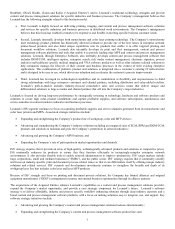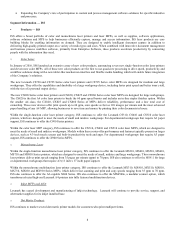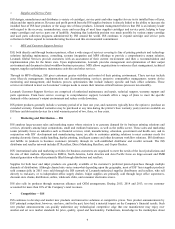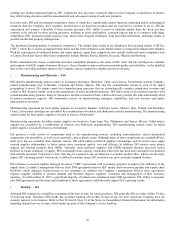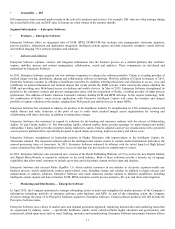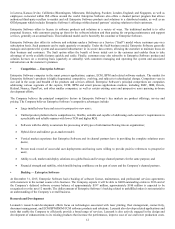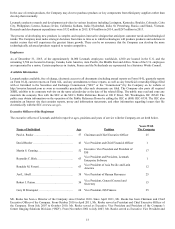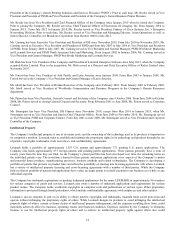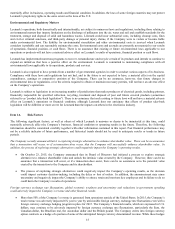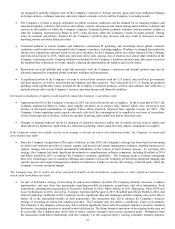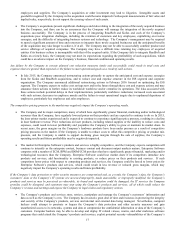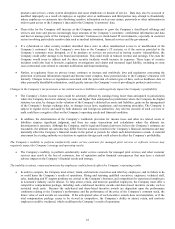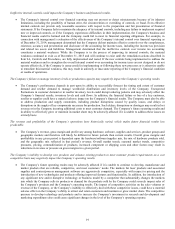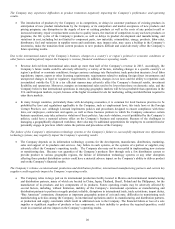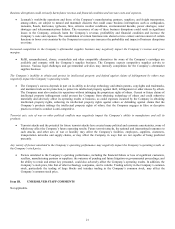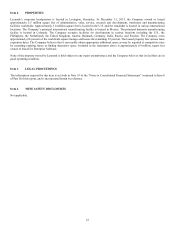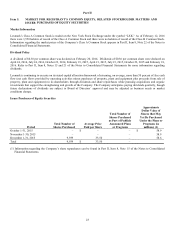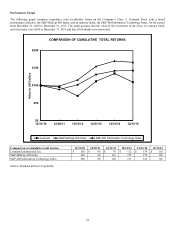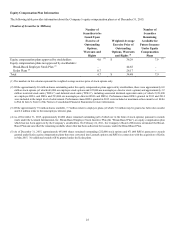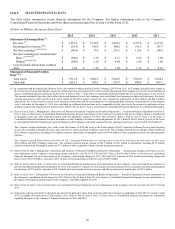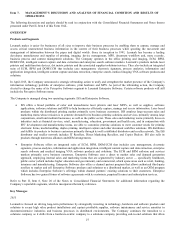Lexmark 2015 Annual Report Download - page 21
Download and view the complete annual report
Please find page 21 of the 2015 Lexmark annual report below. You can navigate through the pages in the report by either clicking on the pages listed below, or by using the keyword search tool below to find specific information within the annual report.17
employees and suppliers. The Company’s acquisition or other investment may lead to litigation. Intangible assets and
goodwill recognized by the Company in the acquisition could become impaired if subsequent measurements of fair value and
implied value, respectively, do not support the carrying values of such assets.
The Company’s acquisitions present significant challenges and risks relating to the integration of the newly acquired business
into the Company, and there can be no assurances that the Company will manage the integration of the newly acquired
business successfully. The Company is in the process of integrating ReadSoft and Kofax and each of the Company’s
acquisitions pose integration challenges, including the retention of customers and key employees, capitalizing on revenue
synergies, and the difficulty of integrating business systems and technology. The Company’s management may be required
to spend a significant amount of time and resources to integrate these newly acquired businesses and the anticipated benefits
of the acquisition may take longer to achieve, if at all. The Company may not be able to successfully combine product and
service offerings of acquired companies. The Company may have a difficult time retaining key employees of acquired
entities if its business culture is incompatible with that of the acquired entity. If the Company fails to integrate ReadSoft and
Kofax on a timely basis, the Company may not meet its expectations regarding the profitability of such acquisitions, which
could have an adverse impact on the Company’s business, financial condition and operating results.
Any failure by the Company to execute planned cost reduction measures timely and successfully could result in total costs and
expenses that are greater than expected or the failure to meet operational goals as a result of such actions.
In July 2015, the Company announced restructuring actions primarily to capture the anticipated cost and expense synergies
from the Kofax and ReadSoft acquisitions, and to reduce cost and expense structure in the ISS segment and corporate
organization. The Company announced additional restructuring actions in February 2016 focused on optimizing the ISS
segment. The Company expects to realize cost savings now and in the future through these cost and expense actions and may
announce future actions to further reduce its worldwide workforce and/or centralize its operations. The risks associated with
these actions include potential delays in their implementation, particularly workforce reductions; increased costs associated
with such actions; decreases in employee morale and the failure to meet operational targets due to unplanned departures of
employees, particularly key employees and sales employees.
The competitive pricing pressure in the market may negatively impact the Company’s operating results.
The Company and its major competitors, many of which have significantly greater financial, marketing and/or technological
resources than the Company, have regularly lowered prices on their products and are expected to continue to do so. In 2015,
the laser printer market experienced and is expected to continue to experience significant price pressure, resulting in a decline
in laser hardware revenue. Price reductions on laser products, including related supplies or the inability to reduce costs and
expenses, could result in lower profitability and jeopardize the Company’s ability to grow or maintain its market share. In
recent years, the gross margins on the Company’s hardware products have been under pressure as a result of competitive
pricing pressures in the market. If the Company is unable to reduce costs to offset this competitive pricing or product mix
pressure, and the Company is unable to support declining gross margins through the sale of supplies, the Company’s
operating results and future profitability may be negatively impacted.
The market for Enterprise Software’s products and services is highly competitive, and the Company expects competition will
continue to intensify as the enterprise content, business content and document output markets mature. Enterprise Software
competes with a number of ECM, BPM and DOM/CCM providers that have significantly greater financial, marketing and/or
technological resources than the Company. Enterprise Software could lose market share if its competitors introduce new
products and services, add functionality to existing products, or reduce prices on their products and services. If such
competitors lower prices with respect to competing products and services, the Company could be forced to lower prices for
Enterprise Software’s products and services, which could result in less revenue or reduced gross margins, which may
negatively impact the Company’s operating results and future profitability.
If the Company’s data protection or other security measures are compromised and, as a result, the Company’s data, the Company’s
customers’ data or the Company’s IT systems are accessed improperly, made unavailable, or improperly modified, the Company’s
products and services may be perceived as vulnerable, its brand and reputation could be damaged, the IT services the Company
provides could be disrupted, and customers may stop using the Company’s products and services, all of which could reduce the
Company’s revenue and earnings and expose the Company to legal claims and regulatory actions.
The Company’s products and services store, retrieve, manipulate and manage the Company’s customers’ information and
data as well as the Company’s own. The Company has invested a great deal of time and resources in protecting the integrity
and security of the Company’s products, services and internal and external data being managed. Nevertheless, computer
hackers could attempt to penetrate or bypass the Company’s data protection and other security measures and gain
unauthorized access to its networks, systems and data or compromise the confidential information or data of the Company’s
customers. Computer hackers may be able to develop and deploy IT related viruses, worms, and other malicious software
programs that could attack the Company’s products and services, exploit potential security vulnerabilities of the Company’s


